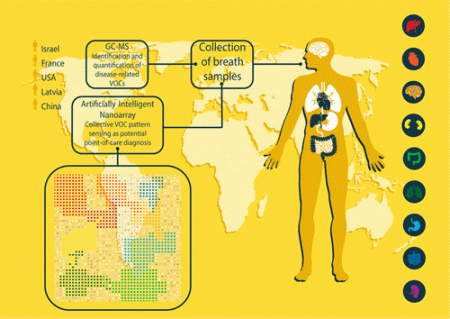January 7, 2017 – A team at Israel Institute of Technology has built a device capable of diagnosing 17 diseases when a patient blows into it. Using gold nanoparticles and an array of carbon nanotubes, the device detects up to 100 volatile compounds that we breathe in and out. The test sample included 2,808 breaths from 1,404 patients. Healthy controls were included in the mix but a majority suffered from at least one of the diseases the array has been designed to detect.
How does it work?
When a patient breaths into the collector, the technology collects a comprehensive dataset of profiles and then applies artificial intelligence (AI) to seek patterns in the types and concentrations of compounds detected. Each disease presents an unique volatile molecular print compared to the breaths of healthy controls and those of other diseases. The presence of one disease does not screen out others, a necessary prerequisite for developing the technology for use in diagnosis. But each of the diseases manifest unique breath prints.
In the schematic above we see a good representation of what the study involved. Samples were collected from nine clinical centres in five countries (Israel, France, United States, Latvia and China). The study population breakdown consisted of 813 patients diagnosed with one of 17 different diseases and 591 healthy controls. Each breathprint needed to differentiate healthy patients from those with the following diseases:
- lung cancer,
- colorectal cancer,
- head and neck cancer,
- ovarian cancer,
- bladder cancer,
- prostate cancer,
- kidney cancer,
- gastric cancer,
- Crohn’s disease,
- ulcerative colitis,
- irritable bowel syndrome,
- idiopathic Parkinson’s,
- atypical Parkinsonism,
- multiple sclerosis,
- pulmonary arterial hypertension,
- pre-eclampsia, and
- chronic kidney disease.
Two types of measurement were done. One screened for diagnosis while the other measured breath chemical composition. The results were published in the December 21, 2016 issue of ACS Nano. The test was accurate in diagnosis 86% of the time. For it to be used in clinical settings the results need to be close to 99%. As the technology improves in accuracy it will contribute to a new generation of non-invasive, inexpensive and portable biomedical devices for personalized diagnosis and classification of diseases.

















